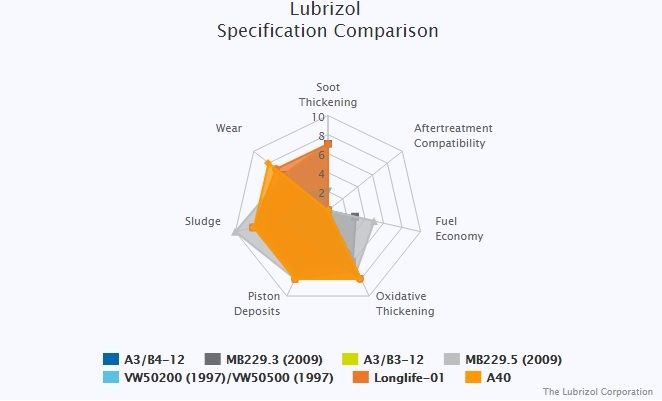https://www.lubrizol.com/apps/relperftool/pc.html
The Lubrizol Comparison tool displays oil based on 7 points of criteria.
1. Soot Thickening
2. Wear
3. Piston Deposits
4. Oxidative Thickening
5. Fuel Economy
6. Aftertreatment Compatibility
7. Sludge
--------------------------------------------------------------------------------------
Aftertreatment Compatibility:
To meet emissions requirements, many engine manufacturers are using aftertreatment systems. These can be affected by lubricant components that reach the system through the exhaust. To achieve aftertreatment compatibility, specifications are being introduced to limit the level of various lubricant components. Reducing components such as sulphur and phosphorus and chemistry that can lead to high sulphated ash can improve lubricant compatibility with the aftertreatment system.
--------------------------------------------------------------------------------------
While viewing a highly regarded oil such as M1 0w-40 with all it's Euro specs, I've noticed the "Aftertreatment Compatibility" section is basically zero.
Would this product be a poor choice in a vehicle the burns some oil since it would be sent to the catalyst (and presumably shorten it's life) ?

The Lubrizol Comparison tool displays oil based on 7 points of criteria.
1. Soot Thickening
2. Wear
3. Piston Deposits
4. Oxidative Thickening
5. Fuel Economy
6. Aftertreatment Compatibility
7. Sludge
--------------------------------------------------------------------------------------
Aftertreatment Compatibility:
To meet emissions requirements, many engine manufacturers are using aftertreatment systems. These can be affected by lubricant components that reach the system through the exhaust. To achieve aftertreatment compatibility, specifications are being introduced to limit the level of various lubricant components. Reducing components such as sulphur and phosphorus and chemistry that can lead to high sulphated ash can improve lubricant compatibility with the aftertreatment system.
--------------------------------------------------------------------------------------
While viewing a highly regarded oil such as M1 0w-40 with all it's Euro specs, I've noticed the "Aftertreatment Compatibility" section is basically zero.
Would this product be a poor choice in a vehicle the burns some oil since it would be sent to the catalyst (and presumably shorten it's life) ?


